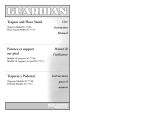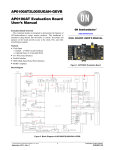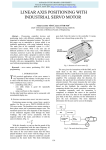Download Datasheet
Transcript
CONTENTS CHAPTER 1 INTRODUCTION OF THE AHA-HSMC............................................................................................ 1 1.1 Features ......................................................................................................................................................1 1.2 About the KIT.............................................................................................................................................2 1.3 Getting Help ...............................................................................................................................................3 CHAPTER 2 AHA CARD ARCHITECTURE............................................................................................................ 4 2.1 Layout and Components.............................................................................................................................4 2.2 Block Diagram of the ISB Board ...............................................................................................................6 CHAPTER 3 BOARD COMPONENTS ..................................................................................................................... 8 3.1 HSMC Expansion Connector .....................................................................................................................8 3.2 Aptina Parallel Port Interface ................................................................................................................... 11 CHAPTER 4 DEMONSTRATIONS ......................................................................................................................... 13 4.1 Design Concept ........................................................................................................................................13 4.2 Demonstration for Altera DE2-115 FPGA Board.....................................................................................14 4.3 Demonstration for Cyclone III Development Board ................................................................................16 CHAPTER 5 APPENDIX ......................................................................................................................................... 19 5.1 Revision History.......................................................................................................................................19 5.2 Copyright Statement .................................................................................................................................19 I Chapter 1 Introduction of the AHA-HSMC FPGAs and image processing are two terms that are becoming linked together in recent years. This is due to the strong advantages FPGAs present when entering into the realm of video and images. By utilizing the inherent parallel structures and computation possible in an FPGA, algorithmic speed is increased dramatically. The birth of the AHA-HSMC daughter card combines the abilities of two giants in the FPGA industry and the image processing industry: Altera Corporation and Aptina Imaging Corporation. The AHA-HSMC is Terasic Technologies’ daughter card solution for sensors from Aptina Imaging Corporation. The AHA-HSMC makes it possible for users with High Speed Mezzanine Connector (HSMC) ports to connect Aptina image sensors to Altera FPGA development kits. 1.1 Features Figure 1-1 shows a photograph of the AHA-HSMC Daughter Card. 1 Figure 1-1 Layout of the AHA-HSMC card The key features of the card are listed below: • • • • Supports I2C configuration for Aptina sensor Support for standard Aptina parallel interface Support for Altera HSMC interface Shutter control function for Aptina Sensor 1.2 About the KIT The AHA-HSMC kit will come with the following contents: • • AHA-HSMC Daughter Card System CD-ROM The system CD contains technical documents of the AHA-HSMC daughter card, which includes components datasheet, reference designs, demonstrations, schematics, cable and user manual (this manual). Figure 1-2 shows the photograph of the AHA-HSMC kit content. 2 Figure 1-2 AHA-HSMC kit package contents 1.3 Getting Help Here is information of how to get help if you encounter any problem: • Terasic Technologies • Tel: +886-3-550-8800 • Email: [email protected] 3 Chapter 2 AHA-HSMC Card Architecture This chapter provides information about architecture and block diagram of the AHA-HSMC card. 2.1 Layout and Components The picture of the AHA-HSMC card is shown in Figure 2-1 and Figure 2-2. It depicts the layout of the board and indicates the locations of the connectors and key components. 4 Figure 2-1 The AHA-HSMC Card PCB and component diagram (top view) 5 Figure 2-2 The AHA-HSMC Card PCB and component diagram (bottom view) 2.2 Block Diagram of the AHA Board Figure 2-3 shows the block diagram of the AHA-HSMC card. The HSMC connector is housing all the wires from peripheral interfaces and makes direct connection to FPGA on the main board. 6 Figure 2-3 Block Diagram of AHA-HSMC card 7 Chapter 3 Board Components 3.1 HSMC Expansion Connector The HSMC interface provides a mechanism to extend the peripheral set of an FPGA host board by means of a mezzanine card, which can address today’s high speed signaling requirement as well as standard or legacy low-speed device interface support. Table 3-1 lists the pin assignments of the HSMC connector. Table 3-1 Pin assignments and descriptions on HSMC connector Pin Numbers 1-41 42 43 44 45 46 47 48 49 50 51 52 53 54 55 56 57 58 59 60 Name IMG_IN_FV CK_FPGA_MCLK VCC3P3 VCC12 IMG_IN_LV VCC3P3 VCC12 IMG_DIN3 VCC3P3 VCC12 IMG_DIN2 Direction Input Output Power Power Input Power Power Input Power Power Input 8 Description Frame valid External clock for sensor Power 3.3V Power 12V Line valid Power 3.3V Power 12V Pixel data Power 3.3V Power 12V Pixel data 61 62 63 64 65 66 67 68 69 70 71 72 73 74 75 76 77 78 79 80 81 82 83 84 85 86 87 88 89 90 91 92 93 94 95 96 97 98 99 100 101 102 103 104 105 SENSOR_RST VCC3P3 VCC12 IMG_DIN11 SHUTTER VCC3P3 VCC12 IMG_DIN10 DEMO2_I2C_SCL VCC3P3 VCC12 IMG_DIN9 DEMO2_I2C_SDA VCC3P3 VCC12 IMG_DIN8 BUF_HISPI_CLK0_EN VCC3P3 VCC12 IMG_DIN7 BUF_HISPI_DATA0_EN VCC3P3 VCC12 CK_IMG_IN_PIXCLK VCC3P3 VCC12 IMG_DIN6 BUF_HISPI_DATA1_EN VCC3P3 Output Power Power Input Output Power Power Input Output Power Power Input Input/Output Power Power Input Output Power Power Input Output Power Power Input Power Power Input Output Power 9 sensor reset Power 3.3V Power 12V Pixel data (MSB) Shutter Power 3.3V Power 12V Pixel data Serial clock Power 3.3V Power 12V Pixel data Serial data Power 3.3V Power 12V Pixel data LVDS outputs enable Power 3.3V Power 12V Pixel data LVDS outputs enable Power 3.3V Power 12V Pixel clock Power 3.3V Power 12V Pixel data LVDS outputs enable Power 3.3V 106 107 108 109 110 111 112 113 114 115 116 117 118 119 120 121 122 123 124 125 126 127 128 129 130 131 132 133 134 135 136 137 138 139 140 141 142 143 144 145 146 147 148 149 150 VCC12 IMG_DIN5 BUF_HISPI_DATA2_EN VCC3P3 VCC12 IMG_DIN4 BUF_HISPI_DATA3_EN VCC3P3 VCC12 IMG_DIN1 VCC3P3 VCC12 IMG_DIN0 VCC3P3 VCC12 LVDS_DATA0_P LVDS_DATA0_N VCC3P3 VCC12 LVDS_DATA2_P LVDS_DATA2_N VCC3P3 VCC12 LVDS_DATA3_P LVDS_DATA3_N VCC3P3 VCC12 LVDS_DATA1_P Power Input Output Power Power Input Output Power Power Input Power Power Input Power Power Input Input Power Power Input Input Power Power Input Input Power Power Input 10 Power 12V Pixel data LVDS outputs enable Power 3.3V Power 12V Pixel data LVDS outputs enable Power 3.3V Power 12V Pixel data Power 3.3V Power 12V Pixel data Power 3.3V Power 12V HISPI serial data differential P HISPI serial data differential N Power 3.3V Power 12V HISPI serial data differential P HISPI serial data differential N Power 3.3V Power 12V HISPI serial data differential P HISPI serial data differential N Power 3.3V Power 12V HISPI serial data differential P 151 152 153 154 155 156 157 158 159 160 LVDS_DATA1_N VCC3P3 VCC12 CK_LVDS_CLK0_P CK_LVDS_CLK0_N VCC3P3 GND Input Power Power Input Input Power Power HISPI serial data differential N Power 3.3V Power 12V HISPI serial clock differential P HISPI serial clock differential N Power 3.3V Power Ground 3.2 Aptina Parallel Port Interface This section describes the Aptina Parallel Port interface on the AHA-HSMC. The AHA-HSMC contains an Aptina Parallel Port interface with a 26-pin header and a 13-pin header. The 26-pin header is the main connector that connects with Aptina image sensor headboard. This header includes most of the control and data bus of the Aptina image sensor, and also provides 5V power to the Aptina image sensor headboard. The 13-pin header contains two sets of pixel data and one shutter control signal. All these signals on Aptina Parallel port are connected to HSMC connector via two level shift chips for logic-level transformation. Table 3-2 and Table 3-3 list the pin assignments of the 26-pin and 13-pin header of Aptina Parallel port, respectively. Table 3-2 Pin assignments and descriptions for 26-pin header (Aptina Parallel) Pin Numbers 1 2 3 4 5 6 7 8 9 10 11 12 13 14 15 16 17 Name SENSOR_D4 SENSOR_D5 SENSOR_D6 SENSOR_D7 SENSOR_D8 SENSOR_D9 SENSOR_D10 SENSOR_D11 SENSOR_D2 SENSOR_D3 GND GND SENSOR_LV SENSOR_RST SENSOR_FV Direction Output Output Output Output Output Output Output Output Output Output Power Power Output Input Output 11 Description Pixel data Pixel data Pixel data Pixel data Pixel data Pixel data Pixel data Pixel data(MSB) Pixel data Pixel data Power GND Power GND Line valid Sensor Reset Frame valid 18 19 20 21 22 23 24 25 26 SENSOR_SDA SENSOR_SCL VCC VCC CK_SENSOR_PIX GND GND CK_DEMO2 Input/Output Input Power Power Output Power Power Power Serial data Serial clock Power 5V Power 5V Pixel clock Power GND Power GND External clock for sensor Table 3-3 Pin assignments and descriptions for 13-pin header (Aptina Parallel) Pin Numbers 1 2 3-10 11 12 13 Name SENSOR_D0 SENSOR_D1 SHUTTER GND Direction Output Output Input Power 12 Description Pixel data Pixel data Shutter Power GND Chapter 4 Demonstrations This chapter shows how to control and retrieve video frames from an Aptina sensor headboard and drive a display device to show the retrieved video. The demonstration requires the following hardware: • FPGA Main Board with HSMC interface • Terasic AHA-HSMC daughter card • Aptina image sensor headboard • LCD Display In the demonstration, Aptina MT9M023 headboard is used. If users use other Aptina image sensor headboards, users will need to modify the design code by themselves for the demonstration to work. 4.1 Design Concept The reference design is developed based on Altera Video and Image Processing Suite (VIP). A custom Camera VIP, provided by Terasic, is designed to retrieve raw image data from the image sensor and decode the raw data to RGB data. Before the FPGA can retrieve the raw data, the image sensor should be configured. In this demonstration, the FPGA configure the registers in the image sensor through an I2C interface. The configure items include: display area, PLL, and gain. Please note: the registers control is sensor type dependent. Users need to refer the register data sheet provided by Aptina for register control. The Camera VIP is a custom VIP-based on Altera VIP and Streaming specifications. It provides the following processes: 13 • Decode Frame-valid, Line-valid and Data-valid to retrieve video raw data - Bayer Pattern • Translate Bayer Pattern to RGB Data • Streaming RGB based on Altera VIP and Streaming Specification Figure 4-1 shows the system generic block diagram of demonstration reference design. Figure 4-1 System Block Diagram of Aptina headboard Demonstration 4.2 Demonstration for Altera DE2-115 FPGA Board This section shows how to setup the video demo on the Altera DE2-115 using camera resolution 800x600. System Requirements • Altera DE2-115 FPGA Board and USB Cable • Terasic AHA-HSMC Daughter Card • CMOS Image Sensor Headboard (MT9M023) • VGA Display and VGA Cable 14 Hardware Setup Figure 4-2 shows the hardware setup for Aptina headboard demonstration with DE2-115 FPGA board. Figure 4-2 Aptina image sensor demonstration hardware setup with DE2-115 Demonstration Setup 1. Make sure the DE2-115 is powered off. 2. Mount the AHA-HSMC daughter card onto the DE2-115 HSMC connector. 3. Plug the Aptina headboard (MT9M023) to AHA-HSMC’s parallel connector. 15 4. Connect VGA display and the DE2-115 VGA port with a VGA cable. 5. Connect the DE2-115 USB-Blaster USB-B port to the PC USB Port with a USB Cable. 6. Connect the power supply to the DE2-115 and turn on the DE2-115. 7. Make sure Quartus 10.1 and NIOS II 10.1 are installed on your system. 8. Copy the folder DE2-115-AHA-HSMC\demo_batch in the AHA-HSMC System CD onto your system and execute “test.bat”. 9. Now, you will see a video display on your VGA monitor. Users can adjust the aperture and focal length of the lens module mount on the Aptina headboard. Demonstration Source Code The source code of this demonstration is located in the following directory of the System CD. Project directory: Demonstration\DE2_115_AHA Note. The project is built by Quartus 10.1, and Altera VIP license is required. 4.3 Demonstration for Cyclone III Development Board This section shows how to setup the video demo on the Altera Cyclone III Development Board. Two demo projects are included using camera resolution of 800x600 and 720p. System Requirements • Altera Cyclone III Development Board and USB Cable • Terasic AHA-HSMC Daughter Card • CMOS Image Sensor (MT9M023) • DVI-HSMC Daughter Card • DVI Display and DVI Cable 16 Hardware Setup Figure 4-3 shows the hardware setup for Aptina headboard demonstration with Cyclone III development board. Figure 4-3 Aptina image sensor demonstration hardware setup with Cyclone III development board Demonstration Setup 1. Make sure the Cyclone III development board is powered off. 2. Mount the AHA-HSMC daughter card onto the Cyclone III development board HSMC B connector. 3. Mount the DVI daughter card onto the Cyclone III development board HSMC A connector. 4. Plug the Aptina headboard (MT9M023) to AHA-HSMC’s parallel connector. 5. Connect DVI display and the DVI daughter card TX port with a DVI cable. 17 6. Connect the Cyclone III development board USB-Blaster port to the PC USB Port with a USB Cable. 7. Connect the power supply to the Cyclone III development board and turn it on. 8. Make sure Quartus 10.1 and NIOS II 10.1 are installed on your system. 9. Copy the folder C3H-AHA\demo_batch in the AHA-HSMC System CD onto your system and execute “test.bat”. 10. Now, you will see a video display on your DVI monitor. Users can adjust the aperture and focal length of the lens module mount on the Aptina headboard. Demonstration Source Code The source code of this demonstration is located in the following directory of the System CD. Project directory: Demonstration\C3H_AHA_800x600 and Demonstration\C3H_AHA_720p Note. The project is built by Quartus 10.1, and Altera VIP license is required. 18 Chapter 5 Appendix 5.1 Revision History Version V1.0 Change Log Initial Version (Preliminary) 5.2 Copyright Statement Copyright © 2011 Terasic Technologies. All rights reserved. Always visit AHA-HSMC webpage for new applications. We will be continuing providing interesting examples and labs on our AHA-HSMC webpage. Please visit www.altera.com or aha.terasic.com for more information. 19

























